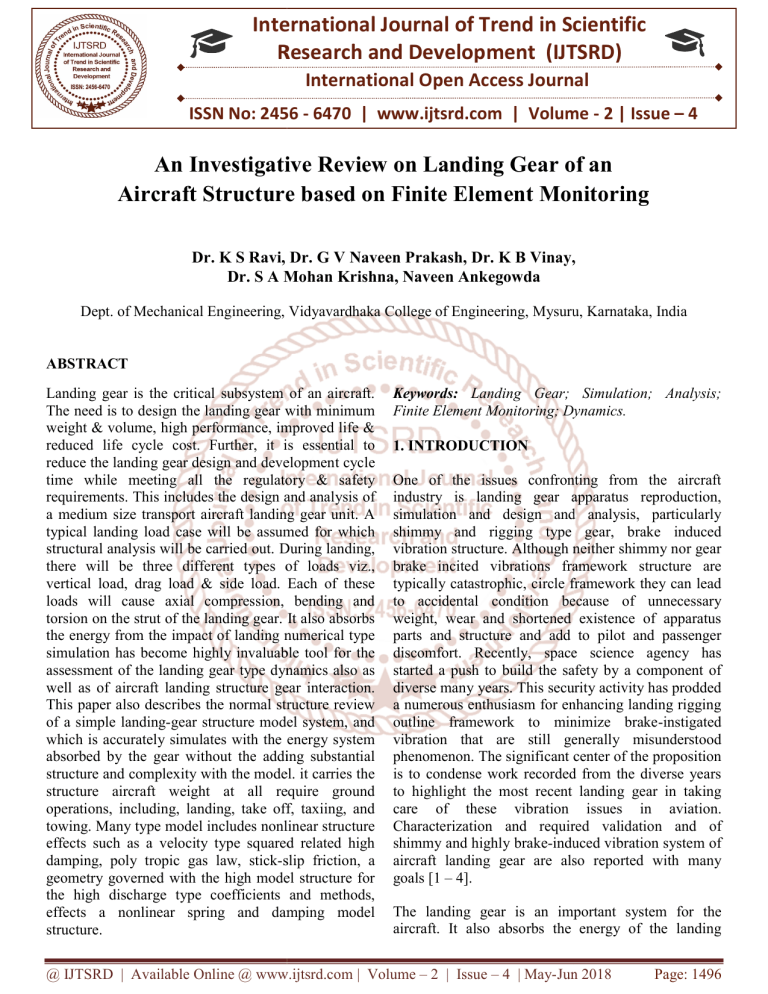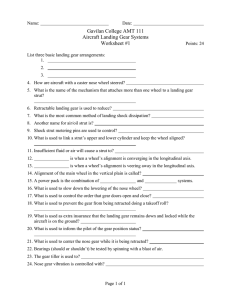
International Journal of Trend in Scientific
Research and Development (IJTSRD)
International Open Access Journal
ISSN No: 2456 - 6470 | www.ijtsrd.com | Volume - 2 | Issue – 4
An Investigative Review on Landing Gear of an
Aircraft Structure based on Finite Element Monitoring
Dr. K S Ravi, Dr. G V Naveen Prakash, Dr. K B Vinay,
Dr. S A Mohan Krishna, Naveen Ankegowda
Dept. of Mechanical Engineering,
ineering, Vidyavardhaka C
College
ollege of Engineering, Mysuru, Karnataka, India
ABSTRACT
Landing gear is the critical subsystem of an aircraft.
The need is to design the landing gear with minimum
weight & volume, high performance, improved life &
reduced life cycle cost. Further, it is essential to
reduce the landing gear design and developmen
development cycle
time while meeting all the regulatory & safety
requirements. This includes the design and analysis of
a medium size transport aircraft landing gear unit. A
typical landing load case will be assumed for which
structural analysis will be carried out. During landing,
there will be three different types of loads viz.,
vertical load, drag load & side load. Each of these
loads will cause axial compression, bending and
torsion on the strut of the landing gear. It also absorbs
the energy from the impact of landing numerical type
simulation has become highly invaluable tool for the
assessment of the landing gear type dynamics also as
well as of aircraft landing structure gear interaction.
This paper also describes the normal structure review
of a simple landing-gear
gear structure model system, and
which is accurately simulates with the energy system
absorbed by the gear without the adding substantial
structure and complexity with the model. it carries the
structure aircraft weight at all require ground
operations, including, landing, take off, taxiing, and
towing. Many type model includes nonlinear structure
effects such as a velocity type squared related high
damping, poly tropic gas law, stick-slip
slip friction, a
geometry governed with the high model structure for
the
he high discharge type coefficients and methods,
effects a nonlinear spring and damping model
structure.
Keywords: Landing Gear; Simulation; Analysis;
Finite Element Monitoring; Dynamics.
1. INTRODUCTION
One of the issues confronting from the aircraft
industry is landing gear apparatus reproduction,
simulation and design and analysis, particularly
shimmy and rigging type gear, brake induced
vibration structure. Although neither shimmy nor gear
brake incited
d vibrations framework structure are
typically catastrophic, circle framework they can lead
to accidental condition because of unnecessary
weight, wear and shortened existence of apparatus
parts and structure and add to pilot and passenger
discomfort. Recently,
ntly, space science agency has
started a push to build the safety by a component of
diverse many years. This security activity has prodded
a numerous enthusiasm for enhancing landing rigging
outline framework to minimize brake-instigated
brake
vibration that are still generally misunderstood
phenomenon. The significant center of the proposition
is to condense work recorded from the diverse years
to highlight the most recent landing gear in taking
care of these vibration issues in aviation.
Characterization and required
quired validation and of
shimmy and highly brake-induced
induced vibration system of
aircraft landing gear are also reported with many
goals [1 – 4].
The landing gear is an important system for the
aircraft. It also absorbs the energy of the landing
@ IJTSRD | Available Online @ www.ijtsrd.com | Volume – 2 | Issue – 4 | May-Jun
Jun 2018
Page: 1496
International Journal of Trend in Scientific Research and Development (IJTSRD) ISSN: 2456-6470
impact that is related to the ground and operations,
including take off, taxiing, and towing structure.
Numerical simulation has become an invaluable
important tool for the assessment of landing gear
system as well as of aircraft/landing gear interaction.
Recent advances in different computational type
speed have made an aircraft and spacecraft crash
structure and its simulations using an explicit, and
nonlinear, transient-dynamic system. Finite Element
Monitoring (FEM) gives the development of a simple
type landing-gear model structure, which accurately
simulates the energy which absorbed by the gear
system without adding substantial type Complexity to
the model. A crash model that the landing gear
response is require approximated with a spring
structure, where the force applied to the engine
fuselage is also computed in a user-written type
subroutine. Aircraft and Helicopter crash simulations
using this approach are compared to and also it is
necessary with the previously acquired experimental
type data from a full-scale type crash test of a
composite manufactured helicopter [3 – 6].
It is important to decide static and element ground
loads for the aircraft structure ground moves precisely
in the outline design stage. Simulation of the critical
operational cases is a better route that contrasted with
the tests on real aircraft to the large examination
heaps at a sensible expense. The simulation and
reproduction of landing gear and ground moves for
different transport carrier is can be introduced and
better route that contrasted with the tests on real
aircraft to the large examine these heaps at a sensible
expense. The flying machine models can be
manufactured by the multibody multiplication,
reproduction device SIMPACK. The model realized
in joins horizontally even components of the model.
Cornering, burden runs and pushback are as ordinary
ground moves. For entertainment of braking, a
fundamental However correct Antilock Braking
System (ABS) calculation is essential. Shimmy
vibration is a fundamental and essential for the
development in the landing gear structure either the
Takeoff or landing of an aircraft and flying machine.
This sort of vibration is given from the dynamic phase
of the forward development of the airplane. In this
manner, this condition begins a restraint empowered
sort of vibration in the wheels that may be achieved.
Weariness, corrosion, fatigue can be observed to be
the primary components and mechanisms. Plan
structure lacks and assembling imperfections drove
predominantly to fatigue while poor material choice
and improve its field upkeep were the principal
starting points of corrosion related failures. Thus, a
series of preventive measures was either prescribed
or re-stressed. While weariness and fatigue can best
be tended to by enhancing the nature of assembling
and by better describing in-service and assembling
and by, much work stays to be done on the timedependent with the degradation process and their
synergism with fatigue, as consumption has regularly
been neglected in both the configuration, design and
testing stages and additionally in the support domain.
Despite the broad arrival landing gear outline, design
and tests completed by the fashioners and the large
makers, and the huge number of inconvenience with
travel free arrivals accumulated by the users, the
Canadian Forces (CF), and also others, have
experienced a large scope of issues or range a
disappointments with landing gear systems [5- 8].
2. FINITE ELEMENT MONITORING
AIRCRAFT LANDING GEAR
OF
Finite Element Monitoring can be employed to model
tooth avoidances and contact examples between both
metallic and non-metallic gear. The initial phase in
assessing tooth diversion, deflection and hence load
sharing is to demonstrate the model tooth contact.
Since, the FEM reproduces the real cross section of
the tooth, it can be utilized to decide burden offering
to assembling mistakes. At long last, the greatest
twisting anxieties can be resolved. For forecast of the
torsional network solidness three its stages were
considered: investigation with incomplete teeth
models, examination with single-tooth apparatus
model and investigation of multi teeth gears over a
complete cross section cycle. The expectation of gear
element loads and it is dependably a noise before you
start to for the substance as a different content
document. These elements are identified with the
gear transmission mistake which is characterized as
the distinction between the positions that the yield
shaft of a gear drive would have if the gearbox was
great.
The transmission mistakes are brought about by the
tooth geometry blunders, versatile disfigurements,
and flawed mounting. Extraordinary limited
components have been created to model twisting, and
torsional disfigurements where different sorts of
assembling structure and gathering of the apparatuses
are considered. The contact connection between two
gear the produces mechanical loads between
associating bodies that can influence their working
@ IJTSRD | Available Online @ www.ijtsrd.com | Volume – 2 | Issue – 4 | May-Jun 2018
Page: 1497
International Journal of Trend in Scientific Research and Development (IJTSRD) ISSN: 2456-6470
conditions. The recognizable proof of the contact
locale is the initial phase in contact investigation
issues. A contact identification calculation relies on
upon the limit estimate of contact questions and can
be for instance, straight lines between hubs, limited
component shape capacities, spline capacities or
uncommon procedures (i.e. pinball calculation). The
outline of riggings comprises as a rule of two
sections: worldwide and nearby (tooth geometry)
apparatus plan. The outline of the nearby tooth
geometry is imperative. The shape, size and position
of the contact spot are the central point in giving
smooth operation of the rigging pair. FEM is a
powerful investigation instrument, will give sensible
results to the rigging conduct. To upgrade the
exactness of the examination a rehashed effect
brought about by element variances of the apparatus
torque can be considered [6 – 12]. The heap
conveying limit and administration life are the
essential prerequisites in the configuration of
riggings. There are four primary disappointment
modes in gear frameworks: tooth bending weariness,
contact fatigue, scoring and surface wear.
(AE) amid landing apparatus airworthiness testing. It
concentrates on the utilization of key part examination
(PCA) to separate between weakness split
engendering (FCP) signs and elevated amounts of
foundation commotion. A simulated AE crack source
was produced and also five sources were utilized to
create contrasting manufactured AE signals. Signs
were recorded from each of the six fake sources in a
genuine landing rigging part subject to no heap. This
extends past work utilizing essential part examination
(PCA) of AE highlight information for sign
discrimination. PCA is a technique used to streamline
high-arrange information sets to lower measurements
to permit a basic investigation. Basically the
information are analyzed in multi-dimensional space
and the two bearings of most prominent difference
(not as a matter of course in accordance with any of
the information measurements), or the vital parts, are
recognized. The information can then be displayed as
a two dimensional x–y plot as far as the two key
segments. The foremost segments are distinguished
utilizing the philosophy laid out underneath [11 – 15].
3. EXPERIMENTS AND ANALYSIS FOR
AIRCRAFT LANDING GEAR
An inventive landing gear modelling methodology
depends in a crash simulation of a full-scale accident
test of a composite helicopter. The simulation
procedure was using the basic arrival gear model with
an unbending and exact model. Helicopter crash
design and simulation utilizing this methodology were
contrasted and procured test information from a fullscale accident test of a composite helicopter. The
accompanying conclusions will be accomplished
come to if the project will effectively finished The
landing gear demonstrating, design and modelling
will be approach precisely recreated with the extent
and introduction of the landing gear power on the
model. The utilization of an unbending rigid model
for a part of the simulation will be suitable and
brought about critical lessening of CPU time for the
aggregate accident recreation and examination.
Synoptically, the arrival landing gear model will be
fruitful at approximating the impact of the stroking
without adding significantly to the model
unpredictability. This rearrangement in conjunction
with the inflexible model assumption can bring about
huge significant reduction in time.
Transport aircraft can be arranged with information
frameworks for hardware, flight controls, and other
basic subsystems. As, an expanded emphasis has been
put on the potential for utilizing these information
capacities, in conjunction with rising sensor and
innovations for checking of flying machine condition
during flight. The potential advantages of fiber optic
sensors include the capacity to access limited or
shortened areas where it is hard to investigate and also
permitting a circulation of sensors at areas around the
aircraft. A specific test can be arranged such that the
sensors for operation on aircraft parts that experience
development or turn during use. Twenty-six FabretPerot Interferometer strain sensors and two long
period grinding (LPG) moisture sensors can be
introduced on the principle gear assembly. The strain
readout frameworks can be prepared to do either
simple or advanced digital to a PC for 5 channels, but
it is the (24 MUX-8) switched type channels also
capable of only digital type output. The gear can be
subjected to cyclic structure loading using a full-scale
shaker type table apparatus at NASA Langley
Research Center.
The work structures a portion of a bigger examination
concerning split location utilizing acoustic outflow
4. SUMMARY
REFERENCES
1. Pritchard, J. (2001). Overview of landing gear
dynamics . Journal of aircraft, 38(1), 130-137.
@ IJTSRD | Available Online @ www.ijtsrd.com | Volume – 2 | Issue – 4 | May-Jun 2018
Page: 1498
International Journal of Trend in Scientific Research and Development (IJTSRD) ISSN: 2456-6470
2. Krüger, W., Besselink, I., Cowling, D., Doan, D.
B., Kortüm, W., & Krabacher, W. (1997), Aircraft
landing gear dynamics simulation and control.
Vehicle System Dynamics, 28(2-3), 119-158.
3. Lyle, K. H., Jackson, K. E., & Fasanella, E. L.
(2002), Simulation of aircraft landing gears with a
nonlinear dynamic finite element code. Journal of
Aircraft,39(1), 142-147.
4. Quayle, A. R., Dowling, A. P., Babinsky, H.,
Graham, W. R., & Sijtsma, P. (2009), Landing
gear for a silent aircraft (Doctoral dissertation,
University of Cambridge).
5. Daniels, J. N. (1996), A method for landing gear
modeling and simulation with experimental
validation (Master's thesis, George Washington
University.
an aid to fatigue fracture detection. Strain, 47(s1),
e588-e594.
13. Lopes, L. V. (2009), A new approach to complete
aircraft landing gear noise prediction (Doctoral
dissertation, The Pennsylvania State University).
14. Kushida, Y., Hara, S., Otsuki, M., Yamada, Y.,
Hashimoto, T., & Kubota, T. (2013), Robust
landing gear system based on a hybrid
momentum exchange impact damper. Journal of
Guidance, Control, and Dynamics, 36(3), 776789.
15. Denery, T., Ghidella, J. R., Mosterman, P. J., &
Shenoy, R. (2006), Creating Flight Simulator
Landing Gear Models Using Multidomain
Modeling Tools. InAIAA Modeling and
Simulation Technologies Conference and
Exhibit (p. 6821).
6. Anurag Dubey, Vamsi Krishna Undavalli, Shri
Shashwat Gupta & Balakrishna Bodramoni
(2015), Landing gear of an aircraft structure,
(Amity University, Noida, Uttar Pradesh, India)
7. Kilner, J. R. (1982), Pneumatic tire model for
aircraft simulation. Journal of Aircraft, 19(10),
851-857.
8. Prášil, L., & Mackerle, J. (2008), Finite element
analyses and simulations of gears and gear drives:
A bibliography 1997- 2006. Engineering
computations, 25(3), 196-219.
9. Freymann, I. R. (1991). Actively damped landing
gear system. AD-A239 914, 16.
10. Prevey, P., Jayaraman, N., Ontko, N., Shepard,
M., Ware, R., & Coate, J. (2004), Mechanical
Suppression of SCC and Corrosion Fatigue
Failures in 300M Steel Landing Gear. LAMBDA
TECHNOLOGIES CINCINNATI OH.
11. Kraft, D. C. (1968), ANALYTICAL LANDING
GEAR-SOILS
INTERACTION-PHASE
1.
DAYTON UNIV OH RESEARCH INST.
12. Eaton, M. J., Pullin, R., Hensman, J. J., Holford,
K. M., Worden, K., & Evans, S. L. (2011),
Principal component analysis of acoustic
emission signals from landing gear components:
@ IJTSRD | Available Online @ www.ijtsrd.com | Volume – 2 | Issue – 4 | May-Jun 2018
Page: 1499





